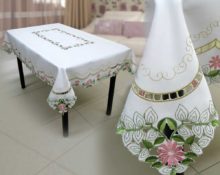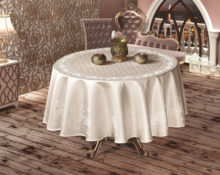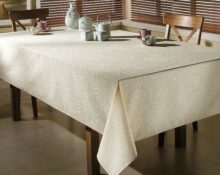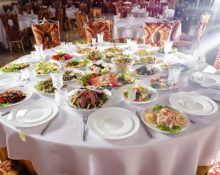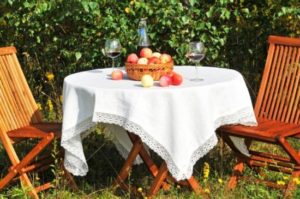 Today everyone has a tablecloth on their table, but has anyone ever thought about how it appeared in our home, who invented it, and why we even cover tables with cloth?
Today everyone has a tablecloth on their table, but has anyone ever thought about how it appeared in our home, who invented it, and why we even cover tables with cloth?
History of the tablecloth
It turns out that the authors are the ancient Egyptians, who wove fabrics masterfully by the standards of those times. From historical sources we can learn that the tablecloths were quite thin, decorated with images of flowers. Thanks to this knowledge, we can learn about the peculiarities of the life of that people, their customs and traditions.
If we pay attention to the painting, we will notice that even in Leonardo da Vinci’s fresco “The Last Supper,” which depicts the last meeting of Jesus Christ with his disciples, there is a tablecloth on the table. This is not the most important element of the picture, but it is still there.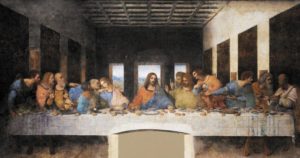
In ancient times, only poor people, peasants, could sit at an uncovered table; richer people covered the table with a beautiful tablecloth during a meal, which served as a sign of a decent financial position.In Ancient Rome, Greece and Persia, craftsmen even wove gold threads to make everything look as luxurious and rich as possible.
At the very beginning, tablecloths were used only to decorate the table, but later they became a worthy part of the interior. But until about the 15th century, people set the table only during lunch or dinner, for the sake of decency. And only in the Renaissance, when interest in man and his activities awakened again, people began to improve in patterns and sewing techniques so that everything would fit perfectly into the interior of their home. Particularly skilled craftsmen bought silk or velvet.
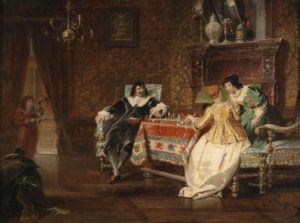 But after the Renaissance comes the era of Classicism, which implies the absence of conspicuous elements. Everything should be formal and no frills. IN XVIII-XIX centuries White tablecloths are coming into fashion; they seem to still breathe Classicism, but its time is already passing. Tables covered with white linen look sophisticated and elegant, which is why this fashion continues to this day. Since the mid-19th century, the love for jewelry has returned. Craftswomen sew crocheted fabrics using white and colored threads. They are also improving their technique; some embroider using satin stitch. It was then that people noticed the grace in the tablecloths that hung from the table straight to the floor.
But after the Renaissance comes the era of Classicism, which implies the absence of conspicuous elements. Everything should be formal and no frills. IN XVIII-XIX centuries White tablecloths are coming into fashion; they seem to still breathe Classicism, but its time is already passing. Tables covered with white linen look sophisticated and elegant, which is why this fashion continues to this day. Since the mid-19th century, the love for jewelry has returned. Craftswomen sew crocheted fabrics using white and colored threads. They are also improving their technique; some embroider using satin stitch. It was then that people noticed the grace in the tablecloths that hung from the table straight to the floor.
Nowadays, there is no longer any specific style or preference; everyone can choose according to their taste. Manufacturers can offer different fabrics and patterns, the range is quite rich.
What did the peasants call the tablecloth?
Important! It is interesting to note that tablecloths appeared in Russia much earlier than in Europe, although usually everything happened exactly the opposite. This is explained by our close trade, political and economic ties with the Byzantine Empire, and hence the transfer of part of their culture to ours.And also the development of sewing and manufacturing technology began to develop, which means that all segments of the population, for example, peasants, could afford to cover the table during lunch.
If rich people were worried about the purity of their speech, and most of the words were borrowed from foreign languages, then they changed little. It will be interesting how the peasants communicated, because they had many of their own invented words that were easy to remember, and they were most likely created thanks to associations.
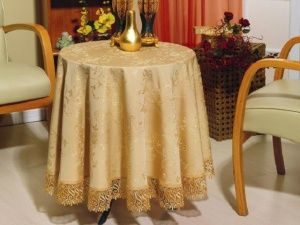 From all the fairy tales and cartoons, we see that in the hut there is a large wooden table and bench right in the middle. Tables were usually made of oak and decorated with carvings. Tablecloths were placed on the tables, and during meals they were covered with embroidered tablecloths, which were called tabletops. In Moscow there is even Stoleshnikov Lane, where once upon a time there lived craftsmen who made tablecloths.
From all the fairy tales and cartoons, we see that in the hut there is a large wooden table and bench right in the middle. Tables were usually made of oak and decorated with carvings. Tablecloths were placed on the tables, and during meals they were covered with embroidered tablecloths, which were called tabletops. In Moscow there is even Stoleshnikov Lane, where once upon a time there lived craftsmen who made tablecloths.
After reading history, it is clear that every thing in our house has a huge history, and sometimes it is worth paying attention to it, it can be interesting.


 0
0